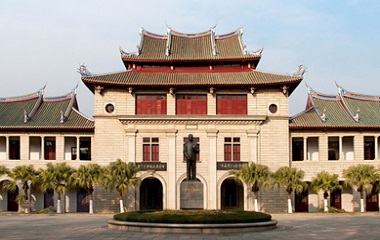[Italy] Lorenzo Giammei, Beijing Foreign Studies University

Although I started learning Chinese four years ago, I can’t remember when I began to yearn for China. I can only say that I have always loved China.
I love traditional Chinese culture. Because the traditional culture has gone through the test of time, people of different eras have bestowed different forms upon it, many of which are still familiar to people today. We can see varied and colorful Chinese characters, tea art and calligraphy throughout Chinese history. The time-honored Chinese traditional culture, like the history of Roman Empire, deeply attracted me.
I love a yellow China. Chinese characters have recorded five thousand years of Chinese civilization. Ancient and time-honored words are a kind of magic and interesting line art. The ever-changing characters express different meanings through the changes of strokes. The most wonderful part of Chinese characters is polyphonic words. The same Chinese character can make various sounds, which can be combined into an interesting sentence.
For example, I have ever seen a pair of couplets. The upper line reads “long, long, long, long, long”, the second line reads “long, long, long, long, long” , and the horizontal line bears “long, long, long” . Sentences written in Chinese characters also express people's emotions, like my favorite Chinese verse, “Death comes to all men, but a loyal heart can live forever.” Only 14 Chinese characters, but all reflect the poet's belief that sacrifice for the country is death in a meaningful way.

I love a green China. Tea leaves can descend its delicate fragrance into a glass of water, and such fragrance can directly diffuse in our hearts. The tea art expresses our feelings and shows classic demeanor. Accompanied with a long history, tea leaves, tea fragrance and tea art have become symbols of China. At the Tianfu Tea House in Beijing, I stepped into the world of tea with the guidance of my Chinese teacher.
I knew about Lu Yu and his Book of Tea, learned about the classification of tea and watched the process of tea processing. In the end, I learned the knowledge of tea art and tea ceremony from the tea art master. I also made a pot of white tea, and served a cup of tea for my teacher to express my gratitude. At that moment, I really understood the meaning of tea and relationships.
I love a black China. I love Chinese calligraphy. I prefer not only the brush, ink, paper and ink stones, but also the structure, shape and artistic conception of calligraphy. From oracle, bronze inscription, small seal script, large seal script, regular script... it expresses the character, life and spirit of a calligrapher.
Chinese say that calligraphy is unlettered poetry, soundless music and uncharted pictures. In the future, I also want to be like the Chinese people to spread the rice paper, pick up the writing brush, dip in the ink, and write my life. I love a red China. Since the reform and opening-up, China has become world-renowned thanks to the innovation of numerous Chinese entrepreneurs.
With the development of China's economy, people's living standards have been gradually improved, and the changes in Chinese society are on full display. As urban overpasses intertwine, roads have become wider and the public transportation more convenient. Electronic technology is widely applied in our daily lives. Online shopping and express delivery have changed people's shopping methods.

I Pass, Alipay, WeChat and other payment methods greatly facilitate people's lives. Sharing bikes and high-speed train make travel easier.In fact, more and more Chinese companies have gone out to the world. China is facing the world with a brand-new look. We are truly amazed at the achievements of China's 40 years of reform and opening-up.
Although I have only learned Chinese for four years, I love China. I love China because it is full of passion, vitality and diversity.
The story is from "My Beautiful Encounter with China" Essay Competition organized by the Chinese Service Center for Scholarly Exchanges (CSCSE).










